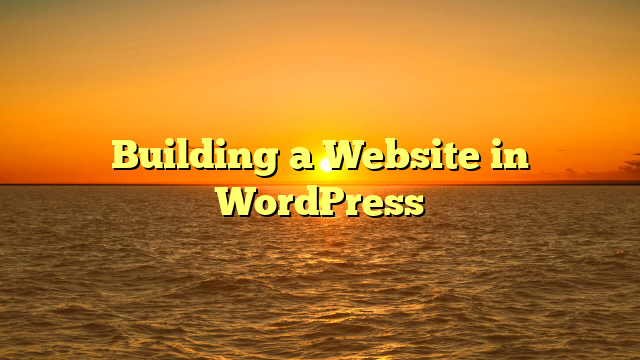Building a Website in WordPress

WordPress is a no-cost open-source CMS that’s extremely easy to install and to customize. It’s search engine optimized (SEO) that means that it is easy for users to find your product or service. If you’re new to building websites it’s a good idea to start with a small scale and stick to a simple. Begin by registering a domain which will be a permanent online home for your website. It should be your business or organization’s name, plus the TLD extension (top-level domain).
WordPress is a completely free and open-source CMS
WordPress is an open-source CMS free of cost that lets you create unlimited websites. It comes with an extensive community and countless paid and free plugins. Many bloggers utilize it due to its open-source nature. Open-source software is completely free to use, modify, and distribute.
WordPress is accessible as a free open-source software that is licensed under the GNU General Public License. This license allows hundreds of developers to be involved in the development of WordPress. It encourages continual improvement, responsibility, free usage, and also free usage. WordPress is designed to be user-friendly and eliminates the need for advanced coding knowledge. It is compatible with many coding languages.
It’s simple to set up
WordPress comes with pre-defined themes that will determine the appearance and feel of your site. If you’d like to have a unique look you can alter the theme once you have installed. Next, you will need to create an account and password. The username will be the username for your WordPress website. The password is used to protect the WordPress administrator section. The theme can be changed whenever you like. You can select the theme you like using the Softaculous software after installation is completed. During the process, you may need to establish an email address which will be used to notify you regarding the installation of the theme.
You will need an account on a hosting service to install WordPress. First, you must create an account with a database inside your hosting account. This is required because WordPress stores its data in the database. Next, you must fill with the information on the WordPress admin panel. Remember to create a strong password for the administrator account since the admin username and password are the primary things that bots and hackers try to guess.
It’s easy to personalize
WordPress lets you personalize your website in many ways. The first step is to select the theme. This theme is like a template for your site. You can easily modify it to suit your needs. You can add widgets or content to further personalize your website.
WordPress has hundreds of themes and plugins. You can alter the color scheme or add a logo, and change the background. You can also add functions such as a contact form or shopping basket. The majority of these changes do not require coding expertise.
It’s SEO friendly.
SEO-friendly websites are an essential element of a digital marketing strategy. WordPress is a great option. WordPress is a platform for managing content (CMS) that follows the most widely used SEO best practices. Utilizing wordpress developer that is SEO friendly will increase the number of users who visit your website.
When creating a site in WordPress you can utilize tools to add metadata to your posts and pages. With plugins such as Yoast SEO, you can add relevant information to each page. Additionally, images are an excellent way to break your text and draw the reader’s attracted to the information. Making sure your images are SEO-friendly is crucial because these images are picked up by web crawlers and help boost your ranking.
It’s simple to backup
WordPress includes a backup option that allows you to export a backup of your entire website in a simple method. Log into your web hosting provider’s cPanel to download your backup. Once connected, right-click on the WordPress directory and choose the option to download or save it as’ to create an archive of backups. From there, you can upload it to your local computer or to a cloud-based storage tool such as Dropbox. You should also make multiple copies of the archive to ensure you have backup copies in case you require it.
A backup could include your website’s files, database plugins, theme files. It can also contain your site’s assets and media files and website content. WordPress recommends backing your site’s files to protect it from any harm. Files include plugin and theme files, as well as codes, images and code. The database holds all the information about your website so backing it up is essential.


Recent Comments